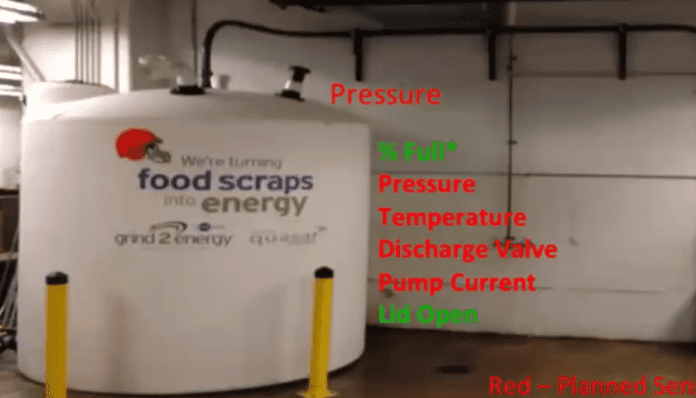Americans toss $165 billion worth of food into the trash each year, according to the Natural Resources Defense Council. That comes out to more than $2,000 per family.
Some of that value can be reclaimed by recycling food waste into energy. Industrial giant Emerson has built huge anaerobic digestion tanks designed to mimic the human body’s digestive process. Just like our bodies, these tanks produce gas, but this methane can be directed into pipes and used to generate electricity. Emerson calls the initiative Grind2Energy.
The food-to-energy idea is appealing to companies that face regulations preventing them from dumping large amounts of food. Enterprises love the idea of monetizing food waste and of course Emerson also wants to make a profit. This requires careful management of the huge, smelly tanks that grind the waste.
Emerson approached AT&T with the idea of connecting the tanks to the carrier’s LTE network. Now the tanks are equipped with AT&T SIM cards and with sensors developed by AT&T partner Red Lion. Emerson also uses AT&T’s M2X and Flow Designer software for data collection analysis. AT&T said the data can facilitate predictive modeling that can help Emerson schedule preventive maintenance.
“The biggest benefit they’re getting is uptime,” said AT&T’s Mobeen Khan, who manages internet of things strategies and products for the carrier. “That’s really what it’s all about. If they can predict maintenance, or figure out how to predict failures and schedule maintenance ahead of time, that is the biggest value that the solution provides.”
AT&T said it’s helping Emerson provide customers with near real-time usage and sustainability reports. The system can also detect clogs and add water as needed, which is key for Emerson customers who do not have anyone on site dedicated to maintaining the tank. Supermarkets, hotels, casinos, sports arenas and restaurants are the target markets for Grind2Energy.
Khan said most of the tanks are inside buildings and often underground. While Grind2Energy currently uses AT&T’s LTE network, the solution would also work well on the carrier’s LTE-M network, which AT&T plans to roll out this year.
“It’s a two-way solution,” said Khan. “Typically you are reading data, but think about if you needed to update the device or update the machinery, you could use the same solution.”
Another key benefit provided by Grind2Energy is food waste monitoring. Because the system measures the amount of food that is discarded, higher-than-expected food waste does not go unnoticed.
For more on Grind2Energy and other ways that carriers are enabling sustainability, see the RCR Wireless News webinar: Carrier IoT Case Studies.
Follow me on Twitter.

